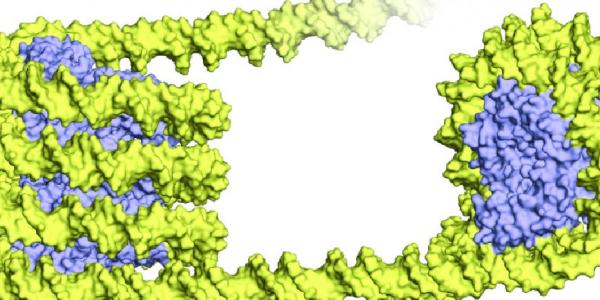Maciej Walczak, CU Boulder associate professor of chemistry, won a $2 million NIH grant to investigate how certain sugars modify a brain protein associated with neurodegeneration
A research laboratory at the University of Colorado Boulder has won a $2 million grant from the National Institutes of Health to explore an uncharted region of Alzheimer’s disease: the chemical interaction of a protein called tau with biomolecules known as glycans.
On the surface, “there’s nothing special about tau. It was discovered in 1975 and was described as just a protein, and there are thousands of proteins in neurons,” says Maciej Walczak, an associate professor of chemistry at CU Boulder and the principal investigator of the Walczak Group.
“But in Alzheimer’s disease patients, that particular protein has an unusually high number of post-translational modifications compared to healthy individuals. We don’t know why that is.”

Maciej Walczak is researcher studying strategies to manipulate and understand the function of biomolecules in human health and disease.
Tau is found in all humans and is abundant in neurons, where it stabilizes the cell’s internal skeleton. Once the protein is produced, different molecules can attach themselves to tau, a process that is called post-translational modification, and change its structure, function and localization.
“Tau is like a string: It’s very floppy, flexible and binds to all sorts of things. It’s intrinsically disordered, which means it doesn’t have a stable structure,” Walczak says. “What that means is that all these residues on tau are available to different enzymes to add small molecules or modifications on the chain site.”
Alzheimer’s is a notoriously perplexing disease, with no treatment in sight after being discovered more than a century ago. Although in past decades most scientists have focused on the protein beta-amyloid as the main component of toxic plaques that cause neurodegeneration, tau was recently brought into the limelight as a key element to understanding the progression of Alzheimer’s.
The Walczak Group first started researching tau and its correlation with Alzheimer’s several years ago in a project led by Wyatt Powell, a PhD student in chemistry who is advised by Walczak.

Researchers in the Walczak Group include (front row, left to right) Kajal Thakur, Ruiheng Jing, (back row, left to right) James Greenwood, Maciej Walczak, Wyatt Powell and Patrick Holland.
“Neurodegeneration is very complex, so there won’t be any one specific factor. Most of the students in the lab are chemists who have a very unique take on this problem because they’re thinking very molecularly,” Walczak says.
With the NIH grant, the Walczak Group plans to study a specific molecular modification to tau that could be causing the spread of neurodegeneration: Glycosylation.
“You’re familiar with sugars and carbohydrates: You eat them, digest them; they’re a source of energy. That’s one role of sugars,” Walczak says. “Their second role is much more interesting from the biological perspective because when they’re added to proteins, they change their structure and function.”
In glycosylation, molecules of sugar known as glycans are added to proteins such as tau and change their structure, an example of post-translational modification. In Alzheimer’s disease patients, the glycosylation of tau is more prominent than in healthy people.
For the NIH project, “We would like to understand the molecular role of glycans attached to tau. Does it change their ability to aggregate and propagate?”
Because neurodegeneration is a progressive disease, toxic fibers of modified tau jump from neuron to neuron. Over several years or decades, large quantities of neurons are killed from this spread. “We want to understand how sugars modulate that process,” Walczak says.
It’s a very important and unsolved problem that will become more pressing because of the increasing aging population in the next few decades.
Although Walczak thinks the lab’s research into the glycosylation of tau is not focused on therapeutic discovery at the moment, he stressed that understanding Alzheimer’s molecular progression will help fill in critical gaps in our knowledge about the disease.
“It’s a very important and unsolved problem that will become more pressing because of the increasing aging population in the next few decades,” Walczak says. “And what I think is fascinating about this disease is that it has various factors, and we don’t really understand what those are.”
“That complexity and challenge has drawn me to pursue this direction. There are a number of fundamental discoveries to be made in the basic biology and mechanism of the disease,” Walczak says.
Walczak also emphasized the importance of the lab’s graduate students, who will be studying neurodegeneration by focusing on glycan’s modifications with various models such as stem cells.
“The modeling of the disease in the lab is very challenging because it’s such a slow process,” Walczak says. “I think we are very lucky we got the NIH grant because it will sustain us to really pursue our goals and create opportunities for new discoveries.”



